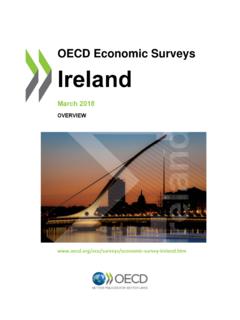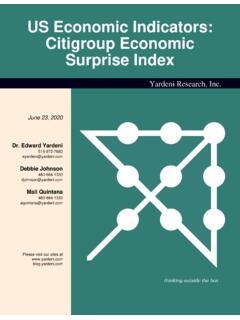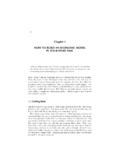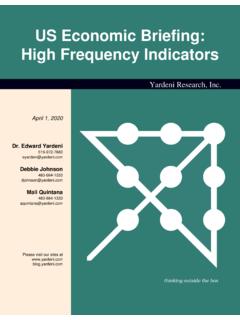Transcription of Economic Welfare and the Allocation of Resources for …
1 This PDF is a selection from an out-of-print volume from the NationalBureau of Economic ResearchVolume Title: The Rate and Direction of Inventive Activity: Economicand Social FactorsVolume Author/Editor: Universities-National Bureau Committee for Economic Research, Committee on Economic Growth of the Social Science Research CouncilVolume Publisher: Princeton University PressVolume ISBN: 0-87014-304-2 Volume URL: Date: 1962 Chapter Title: Economic Welfare and the Allocation of Resources for InventionChapter Author: Kenneth ArrowChapter URL: pages in book: (p. 609 - 626) Economic Welfare and the Allocation ofResources for InventionKENNETH J.
2 ARROWTHE RAND CORPORATIONINVENTION is here interpreted broadly as the production of know-ledge. From the viewpoint of Welfare economics, the determinationof optimal resource Allocation for invention will depend on the tech-nological characteristics of the invention process and the nature ofthe market for classic question of Welfare economics will be asked here: towhat extent does perfect competition lead to an optimal Allocation ofresources? We know from years of patient refinement that competitioninsures the achievement of a Pareto optimum under certain model usually assumes among other things, that (1) the utilityfunctions of consumers and the transformation functions of pro-ducers are well-defined functions of the commodities in the economicsystem, and (2) the transformation functions do not display indivisibi-lities (more strictly, the transformation sets are convex).
3 The secondcondition needs no comment. The first seems to be innocuous butin fact conceals two basic assumptions of the usual models. It pro-hibits uncertainty in the production relations and in the utility func-tions, and it requires that all the commodities relevant either to pro-duction or to the Welfare of individuals be traded on the market. Thiswill not be the case when a commodity for one reason or anothercannot be made into private have then three of the classical reasons for the possible failureof perfect competition to achieve optimality in resource Allocation :indivisibilities, inappropriability, and uncertainty.
4 The first problemhas been much studied in the literature under the heading of marginal-cost pricing and the second under that of divergence between socialand private benefit (or cost), but the theory of optimal Allocation ofresources under uncertainty has had much less attention. I will sum-marize what formal theory exists and then point to the critical notionof information, which arises only in the context of uncertainty. TheNOTE: I have benefited greatly from the comments of my colleague, William am also indebted to Richard R. Nelson, Edward Phelps, and Sidney Winter of TheRAND Corporation for their helpful ECONOMICS AND INVENTiVE ACTIVITY Economic characteristics of information as a commodity and, inparticular, of invention as a process for the production of informationare next examined.
5 It is shown that all three of the reasons given abovefor a failure of the competitive system to achieve an optimal resourceallocation hold in the case of invention. On theoretical grounds anumber of considerations are adduced as to the likely biases in themisallocation and the implications for Economic organization.' resource Allocation under UncertaintyThe role of the competitive system in allocating uncertainty seems tohave received little systematic I will first sketch an idealeconomy in which the Allocation problem can be solved by competitionand then indicate some of the devices in the real world which approxi-mate this for simplicity that uncertainty occurs only in productionrelations.
6 Producers have to make a decision on inputs at the presentmoment, but the outputs are not completely predictable from the in-puts. We may formally describe the outputs as determined by the in-puts and a "state of nature" which is unknown to the producers. Letus define a "commodity-option" as a commodity in the ordinary senselabeled with a state of nature. This definition is analogous to the differ-entiation of a given physical commodity according to date in capitaltheory or according to place in location theory. The production of agiven commodity under uncertainty can then be described as theproduction of a vector of description can be most easily exemplified by reference toagricultural production.
7 The state of nature may be identified with theweather. Then, to any given set of inputs there corresponds a numberof bushels of wheat if the rainfall is good and a different number ifrainfall is bad. We can introduce intermediate of rainfall1 Forotheranalyses withsimilar points of view, see R. R. Nelson, "The SimpleEconomics of Basic Scientific Research," Journal of Political Economy, 1959, pp. 297 306;and C. J. Hitch, "The Character of Research and Development in a CompetitiveEconomy," The RAND Corporation, p. 1297, May studies lam aware of are the papers of M. Allais and myself, both presentedin 1952 to the Colloque International sur le Risque in Paris; see M.
8 Allais, "G n ralisationdes theories de l' quilibre conomique g n ral et du rendement social au cas du risque,"and K. J. Arrow, "Role des valeurs bousi res pour Ia repartition Ia meilleure des risques,"both in Econom irie,ColloquesInternationaux du Centre National de Ia RecliercheScientifique, Vol. XL, Paris, Centre National de Ia Recherche Scientifique, 'paper has also appeared in Econometrica, 1953, pp. 269 290. The theory has received avery elegant generalization by G. Debreu in Theory of Values, New York, Wiley, 1959,Chap. OF Resources FOR INVENTIONin any number as alternative states of nature; we can increase thenumber of relevant variables which enter into the description of thestate of nature, for example by adding temperature.
9 By extension ofthis procedure, we can give a formal description of any kind of uncer-tainty in and this is the critical idealization of the economy wehave a market for all commodity-options. What is traded on eachmarket are contracts in which the buyers pay an agreed sum and thesellers agree to deliver prescribed quantities of a given commodityifacertain state of nature prevails and nothing if that state ofnature does not occur. For any given set of inputs, the firm knowsits output under each state of nature and sells a corresponding quantityof commodity-options; its revenue is then completely determined.
10 Itmay choose its inputs so as to maximize income of consumers is derived from their sale of supplies,including labor, to firms and their receipt of profits, which are assumedcompletely distributed. They purchase commodity-options so as tomaximize their expected utility given the budget restraint imposed bytheir incomes. An equilibrium is reached on all commodity-optionmarkets, and this equilibrium has precisely the same Pareto-optimalityproperties as competitive equilibrium under particular, the markets for commodity-options in this idealmodel serve the function of achieving an optimal Allocation of riskbearing among the members of the economy.

















